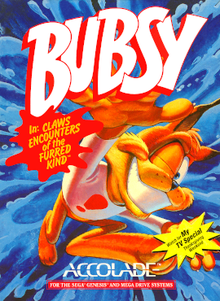
The Master System is an 8-bit third-generation home video game console manufactured and developed by Sega. It was originally a remodeled export version of the Sega Mark III, the third iteration of the SG-1000 series of consoles, which was released in Japan in 1985 with graphical capabilities improved over its predecessors. The Master System launched in North America in 1986, followed by Europe in 1987, and then in Brazil and Korea in 1989. A Japanese version of the Master System was also launched in 1987, which features a few enhancements over the export models : a built-in FM audio chip, a rapid-fire switch, and a dedicated port for the 3D glasses. The Master System II, a cheaper model, was released in 1990 in North America, Australasia and Europe.

Sonic the Hedgehog is a 1991 platform game developed by Sonic Team and published by Sega for the Genesis/Mega Drive. It was released in North America on June 23 and in PAL regions and Japan the following month. Players control Sonic the Hedgehog, who can run at near supersonic speeds; Sonic sets out on a quest to defeat Dr. Robotnik, a scientist who has imprisoned animals in robots and seeks the powerful Chaos Emeralds. The gameplay involves collecting rings as a form of health, and a simple control scheme, with jumping and attacking controlled by a single button.

Accolade, Inc. was an American video game developer and publisher based in San Jose, California. The company was founded as Accolade in 1984 by Alan Miller and Bob Whitehead, who had previously co-founded Activision in 1979. The company became known for numerous sports game series, including HardBall!, Jack Nicklaus and Test Drive.
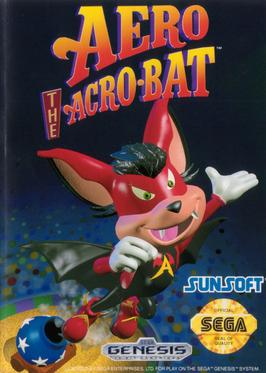
Aero the Acro-Bat is a 1993 video game developed by Iguana Entertainment and published by Sunsoft. It was released for both the Super Nintendo Entertainment System and Sega Genesis. Aero the Acro-Bat, a red anthropomorphic bat, was created by David Siller. In 2002, Metro 3D released a version of the game for the Game Boy Advance, with a battery back-up. The GBA version was titled Aero The Acro-Bat - Rascal Rival Revenge in Europe and Acrobat Kid in Japan. The Super NES version of the game was released on the Wii's Virtual Console in the PAL region on July 23 and in North America on July 26, 2010.
1992 saw many sequels and prequels in video games, such as Dragon Quest V, Final Fantasy V, Sonic the Hedgehog 2, Street Fighter II: Champion Edition, Super Mario Land 2: 6 Golden Coins, and Super Mario Kart, along with new titles such as Art of Fighting, Lethal Enforcers, Mortal Kombat and Virtua Racing.

Bubsy is a series of platforming video games created by Michael Berlyn and developed and published by Accolade. The games star an anthropomorphic bobcat named Bubsy, a character that takes inspiration from Super Mario Bros. and Sonic the Hedgehog. The games were originally released for the Super NES, Mega Drive/Genesis, Game Boy, Jaguar, PC and PlayStation during the 1990s.
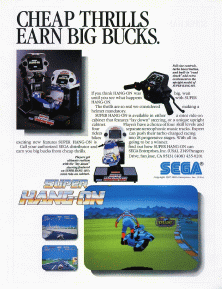
Super Hang-On is a motorcycle racing arcade video game released by Sega as the sequel to Hang-On. It uses a simulated motorcycle arcade cabinet, like the original game. An updated version was released in arcades 1991 as Limited Edition Hang-On.
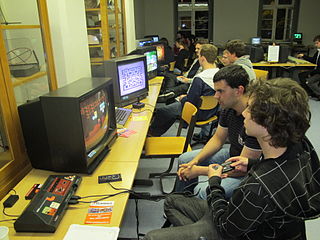
Retrogaming, also known as classic gaming and old school gaming, is the playing and collection of obsolete personal computers, consoles, and video games. Usually, retrogaming is based upon systems that are outmoded or discontinued, although ported retrogaming allows games to be played on modern hardware via ports or compilations. It is typically for nostalgia, preservation, or authenticity. A new game could be retro styled, such as an RPG with turn-based combat and pixel art in isometric camera perspective.

The Sega Genesis, also known as the Mega Drive outside North America, is a 16-bit fourth generation home video game console developed and sold by Sega. It was Sega's third console and the successor to the Master System. Sega released it in 1988 in Japan as the Mega Drive, and in 1989 in North America as the Genesis. In 1990, it was distributed as the Mega Drive by Virgin Mastertronic in Europe, Ozisoft in Australasia, and Tectoy in Brazil. In South Korea, it was distributed by Samsung Electronics as the Super Gam*Boy and later the Super Aladdin Boy.
Michael Berlyn was an American video game designer and writer. He was best known as an implementer at Infocom, part of the text adventure game design team. He is also known as the designer behind Bubsy in Claws Encounters of the Furred Kind (1993) and Bubsy 3D (1996).

Barkley Shut Up and Jam! is a basketball video game originally developed and published by Accolade for the Sega Genesis on North America in 1993 and later in Europe in April 1994. The game is the first entry in the Barkley Shut Up and Jam series, featuring former NBA MVP Charles Barkley prominently and as one of the playable characters.

Bubsy 3D is a platformer game developed by Eidetic and published by Accolade. It is the first 3D game in the Bubsy series, and the fourth game in the series overall. The game was released for the PlayStation on November 25, 1996, in North America, with a later European release in August 1997. Bubsy 3D follows the series' titular character, an orange bobcat named Bubsy, who travels to the planet Rayon to stop the alien Woolies, and return safely to Earth.

HardBall III is a multiplatform baseball video game developed by MindSpan and published by Accolade between 1992 and 1994 for the Sega Genesis, Super Nintendo Entertainment System and DOS platforms. The game is licensed by the Major League Baseball Players Association and is the sequel to HardBall II.
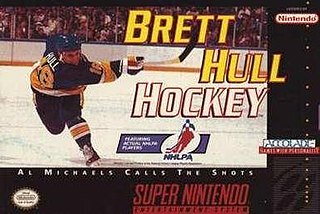
Brett Hull Hockey is an ice hockey video game developed by Radical Entertainment and originally published by Accolade for the Super Nintendo Entertainment System in North America in January 1994. It prominently features former Canadian-American NHL player Brett Hull and is officially licensed from the NHL Players' Association.

Break Time: The National Pool Tour is a pocket billiards (pool) video game released for the Nintendo Entertainment System in 1993 exclusively for a North American audience.

Bubsy 2 is a platform video game, the sequel to Bubsy in Claws Encounters of the Furred Kind, and the second game in the Bubsy series. It was originally released by Accolade in 1994 for the Sega Genesis, Super NES, and Game Boy, and re-released for Windows through Steam on December 17, 2015.

Bubsy in: Fractured Furry Tales is a platform video game developed by Imagitec Design and published by Atari Corporation for the Atari Jaguar in North America on December 1994, and Europe in January 1995. The third entry in the Bubsy series, the plot follows the titular character, who ventures through a realm of fairy tales to restore order and protect children all over the world from creatures and antagonists of corrupted fairy tales, which appeared after Mother Goose was captured by Hansel and Gretel.

Bubsy: The Woolies Strike Back is a platform game developed by Black Forest Games and published by UFO Interactive Games under the Accolade label. It was released for PlayStation 4 and Windows on 31 October 2017. The game is the fifth installment in the Bubsy series, and the first new entry in 21 years since Bubsy 3D.
